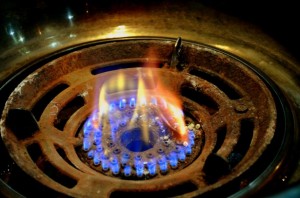Believe it or not, the natural gas that you utilize to heat your home is something remarkably different from the natural gas that is extracted from the ground. In order to transform it into a safe, and efficient fuel used to heat your home, the natural gas from the ground goes through a refining process. The purpose of this blog post is to provide a brief overview of the natural gas refining process.
A Naturally Complex Mixture
The natural gas that is used in your home is comprised almost entirely of methane gas. When it comes out of the ground, it is usually a mixture of different natural gases, oils and gasoline. These can include things such as ethane, propane, butane, and gases from the pentane group. Things such as water vapor, carbon dioxide, helium, nitrogen, and hydrogen sulfide are often present as well.
The refining process is one of separation. The result desired is to “refine” out all the unnecessary ingredients and transform it into what is known as “pipeline quality” dry natural gas. This is done partly because the pipelines used to transport the natural gas to your community will often have restrictions on the composition that is allowed to enter their system. Essentially if it doesn’t meet their standards or requirements, it’s not even getting into the pipes, much less going into your home.
The Refining Process in Simple Terms
In most cases, natural gas is refined primarily at the processing plant. While the process can be rather complex, and involve many different plants and operations, it essentially boils down to four main components:
- Oil and Condensate Removal
- Water Removal
- Separation of Natural Gas Liquids
- Sulfur and Carbon Dioxide Removal.
The oil and condensate removal is accomplished in most cases by placing the material in something called a conventional separator. The mixture is placed into the tank, and since the oil and condensates are heavier than the natural gas they will separate to the bottom of the tank where they are removed.
Removal of the water which is in solution with the natural gas is usually done through one of two processes- absorption, or adsorption. The first, absorption is accomplished with the use of a dehydrating agent- such as Glycol is used to pull the moisture out of the mixture. The second method, adsorption occurs when the water is made to condense out of solution on to various surfaces.
The separation of natural gas liquids is often accomplished through extraction. There are two main ways to do this- the first is absorption, which occurs in pipes and absorption towers, and is very much like the water removal process. The second method used is the cryogenic expander process. This is often used to extract some of the lighter NGLs like ethane. Essentially in this process the temperature of the mixture is dropped to approximately -120º F., usually by using external refrigerants to cool the mixture, then using an expander turbine to expand the mixture, dropping the temper even more. Once the temperature drops, the NGL will condense, while the methane remains in gaseous form.
Once the oil, water, and NGLs have been removed, both sulfur and carbon dioxide needs to be removed. This is done through a process called “sweetening”. One of the most common methods of sweetening the mixture is called the amine process. The gas mixture is run through a tower which contains amine solution- either monoethanolamine (MEA) or diethanolamine (DEA), both of which have an affinity for sulfur compounds. As the gas travels through the tower, the hydrogen sulfide compounds are pulled out, and the natural gas passes right through. The carbon dioxide is often removed through iron scrubbers or membranes, which allow the natural gas to pass through, but trap the carbon dioxide.
Remember, this is just a basic overview. The process in it’s entirety is a bit more complex, with a lot more steps. If you have further questions, please take a look at the resources provided below.


